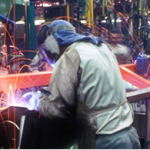BS EN 1090 1 & CE Marking
Structural Steelwork

In 2012 The Construction Products Regulations (CPR) was introduced, this places a requirement on construction products that have a harmonised standard to be CE Marked.
The European Construction Products Directive is aimed at harmonising the safety performance of construction products across the EU and they apply to anything placed on the market, whether imported or manufactured in the EU. The CPD defines six principles for materials that are to be used in civil engineering including:
- Mechanical resistance & stability (ITT / initial type testing)
- Safety in case of fire (fire testing)
- Hygiene, health & the environment (design)
- Safety in use (clear usage instructions & risk assessment )
- Protection against noise (risk assessment)
- Energy economy & heat retention (environmental performance)
New legislation was introduced in 2013 to allow the CPR to be enforced by the Trading Standards authority, which now has the power to stop a business from trading and to withdraw any products supplied. In severe cases Directors may also be imprisoned for not complying with EN 1090-1.
The net benefit of EN 1090-1 is the elimination of risks emanating from steelwork being either under or over the requisite specification for a particular application. With the ability to select steelwork that has been CE marked in an appropriate manner, contractors will derive increased levels of confidence that their structural steelwork will provide the requisite performance and extended life in service. In addition, specifiers are now able to differentiate differing levels of expertise from a range of suppliers, which in turn helps with cost effective and peace of mind procurement.
As a result, construction contractors can have increased confidence in the efficiency and suitability of their structure. Now, special production runs can be undertaken to match the demands of the end use requirement by stipulating the execution class before steelwork fabrication is undertaken.
So, CE marking enables construction industry contractors to have increased levels of confidence in the structural steelwork quality. Contractors that use fabricators with third party certification can have greater confidence that their fabrications have been optimised to their specific application requirements.
Most important of all, is the reduction of risk in steel structures. Greater confidence in the quality of structural steelwork corresponds with more reliable, safer structures in order to ensure that all types of structure have the requisite suitability and integrity for its application.
Who needs to comply with BS EN 1090-1 ?
The BS EN 1090 1 CE marking for structural steel regulations apply to a wide range of activities involving “series” manufactured items:
- Manufacturers of metal components or kits that have a structural use in civil engineering.
- Importers of structural metalwork kits or components
- Stockholders and metal processors that modify stock – for example by drilling, painting, bending, electroplating etc.
Within EN 1901-1 The term “series” means mass produced or more than one for example multiple production such as staircases but not necessarily an access platform as a one off (non series) production, however the controls required are same and many larger organisations purchasing structural/fabricated steel may insist on CE Marking to ensure they have net their legal duty of care.
What do I need to do to comply BS EN 1090 1 ?
There are 3 “consequence classes” in EN 1090-1 and it is anticipated that the majority of structural steel fabricators in the UK will fall within consequence class 2.
| Consequence class 1 (CC 1) | Low | Low possibility of loss of human life, or economic impact, social or environmental consequence – minimal to negligible loss | Agricultural buildings where people do not normally enter, low use, storage areas, greenhouses, etc. |
| Consequence class 2 (CC 2) | Medium | Medium possibility of loss of human life, or economic impact, social or environmental consequence – considerable loss | Residential and or office buildings with regular use, although not highly populated |
| Consequence class 3 (CC 3) | High | High possibility of loss of human life, or economic impact, social or environmental consequence –very great and serious impact | Stadium, concert hall, public buildings, etc. human activity very high usage most days of the year |
You need to have what is known as an FPC (Factory Production Control system) this is set of procedures and documentation that ensure the following amongst other requirements:
- Traceability of materials (to original mill certs and test results)
- Competence of welders/fabricators (coded welders/weld testing)
- A responsible welding coordinator needs to be appointed
- Drawings and calculations to prove the structural integrity of materials/fabricated items
- Calibration of equipment (welding equipment)
- Control of defective materials and products with corrective action process (fixing errors)
- Purchasing procedures and approval for materials and subcontractors
- Quality control systems to ensure the quality of manufactured products
Holding certification to ISO 9001 will provide the majority of evidence required for EN 1090 1 but you will need some additional controls as detailed above. When all this is in place you need to have a third party audit/inspection by a notified body which is UKAS accredited.
Can We Help You With EN 1090-1 Certification?
We have a team of consultants who are also 3rd party auditors recommending certification to EN 1090 1 so fully understand the certification process inside out.
We have developed standard documentation and procedures that ensure compliance to the requirements of both ISO 9001 and EN 1090 1.
We will carry out an initial gap analysis:
- Provide all necessary documentation including procedures forms etc..
- Generate an action plan
- Develop any additional controls and documentation
- Liaise with a UKAS accredited certification body to arrange certification
- On-going support to maintain certification (where requested)
Where companies meet certain criteria, we may also be able to access financial support to implement your system.
Please contact us to discuss how we can help your business.
